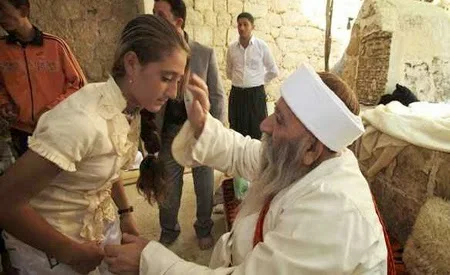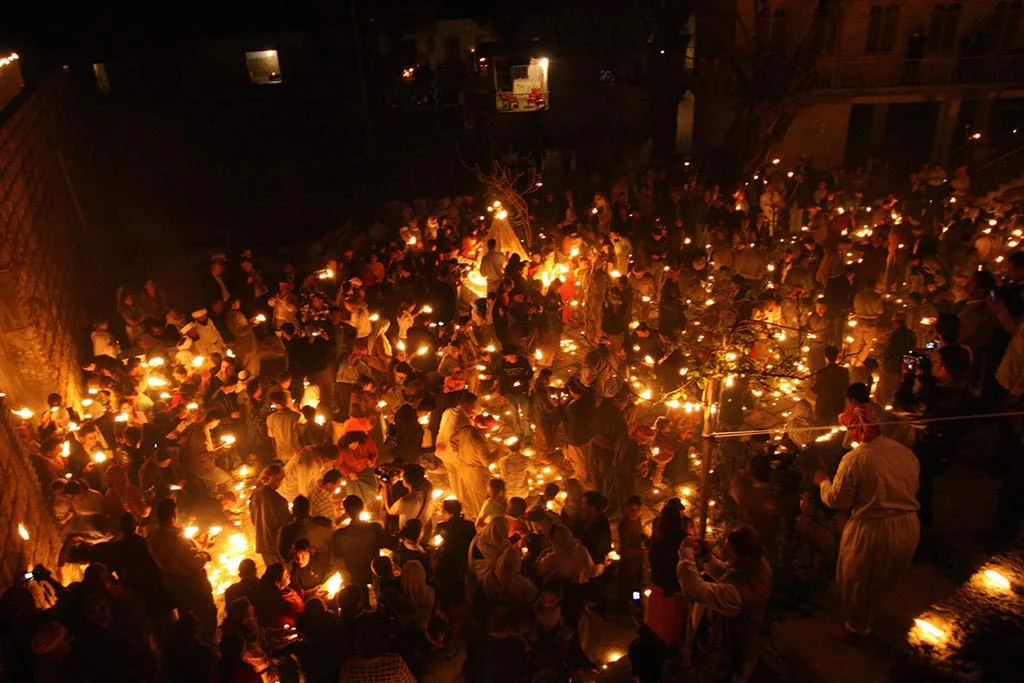The Yezidis are a very ancient people from Iraq with their calender being 6764 yrs old. About 5000 years ago Yezidis migrated from India to Afghanistan, Iran, Iraq, and the middle east. At that time they were called children of Melek Taus same as Murugan, a God found in the south of India. The religion of Yezidis shares much in common with Vedic Hindus. Yezidis believe in reincarnation. Peacock finds a special place, which is worshiped as Melek taus/Murugan. No peacock is found in Iraq or the middle east but is native to India. The language in which the Yezidi holy books are written is Avesta which is thought to be the same language as Sanskrit. Lord Rama is also one of the Yezidi Gods. The temple tops of the Yezidis look much like the Hindu temples. The serpent is the totem of Melek Taus/Murugan and symbolizes the Kundalini released.
 |
| The temple tops of the Yezidis look much like the Hindu temples |
210,000 Hindu Yezidis have lost their lives in the genocide of the Srinjar mountains by ISIS in just 10 days. In the Srinjar mountains, children lived on the blood of their parents for days without water. Unable to see the children die before them or being kidnapped, sold, raped and tortured, the parents threw their children from mountain tops. Half a million Hindu Yezidis have been rendered homeless with a harsh winter approaching them and with no winter wear.
There is a prophecy, which the Yezidis have believed for thousands of years, that says all Aryan tribes (the word Aryan does not refer to race, it simply means "The Righteous") will one day be united in spiritual harmony as one people. The Yezidi Sanatana Dharma Society is part of the realization of that prophecy. The last of the Aryan tribes come into the Hindu fold. Please welcome them.
Peacock Angel = Vedic & Yezidi
Yezidis and Hindus revere Malik Taus or Skanda-Murugan, the Peacock Angel King
Yezidis and Hindus led by the Yezidi Sanatan Dharma Society join hands for the Yezidi cause
by Nallein Satana Al-Jilwah Sowilo and Vrndavan Brannon Parker
The Yezidis are an Aryan people originally from Airyna Vaeja, the mystical homeland of Aryans, who today live primarily in the Nineveh Province of Iraqi Kurdistan. The word Aryan is not related to race but refers to ‘The Righteous’. The Yezidi calendar is 6,764 years old and is the oldest in the Middle East. It is believed that about five thousand years ago the Yezidis migrated to Afghanistan, Iran, Iraq, and the Middle East. At that time they were called the children of Melek Taus. Melek or Malik is an ancient Semite god of Babel and Canaan. Melek or Malik can be seen in the old Tamil word Malaiklavon, another name for Murugan, the equally ancient and still hugely popular Tamil god of South India.
 |
| Vedic people of Iraq |
Airyna Vaeja was an empire of Aryans which included present-day India. It also included Turkmenistan, Uzbekistan, Afghanistan, and Meda. Meda was part of Iran (a name rooted in the term Aryan) which is in present-day Kurdistan. In the Avesta text and Shahnameh text, the legendary King Jamshid of Airyana Vaeja is mentioned. The name Jamshid is a later version of the name Yima Sira or Yima Khshaeta. Yima means 'the radiant'. In Avesta, Jamshid is called Yima, son of Vivanghat. While in the Vedas he is called Yama, son of Vivasvant also known as Surya or the Sun god.
 |
| The Peacock finds a special place in their religion. It is worshiped as Melek Ta'us/Murugan/Skanda/Kārttikeya. |
The Avesta language was named after the Avesta text of the Zoroastrians.
Peacock Angel EyeThe language and style of old Avesta and Rig Veda are so close that they are commonly thought to be different versions of the same language of Sanskrit. The religion of the Yezidis shares much in common with Vedic Hindus. Yezidis have a caste system like Hindus. However, no caste-based discrimination has ever been reported among the Yezidis. Yezidis also believe in reincarnation. The Peacock finds a special place in their religion. It is worshiped as Melek Ta'us/Murugan/Skanda/Kārttikeya.
.jpg) |
| Temple Entrance |
The peacock is not native to Iraq or the Middle East but is indigenous to India. The serpent is the totem of Melek Ta'us/Murugan in Yezidi. Like the Hindu Indian Murugan, the serpent symbolizes the kundalini released. Exactly like the Hindus the Yezidis use tilak and place the mark upon their foreheads. Another clue in Yezidi to the location of their homeland lies in the mythology of their holy land called Perani which is derived from the word Pazhani, a temple in the Dindigul District of Tamil Nadu. The deity there is Murugan or Karttikeya.
The present crisis represents the 74th instance of genocide
 |
| The Baba Sheikh, spiritual leader of the Yezidi faithful, blesses a Yezidi girl. Like Hindus, the Yezidis place the tilak mark upon their foreheads. |
The present crisis represents the 74th instance of genocide committed against this ancient peace-loving people. It began with an attack on Shingal where most of the Yezidi population resides. The latest attack began in May 2014 when ISIL crossed into Iraq from Syria. The Yezidi tribal leaders were able to fight ISIL in the plains. In the mountains, the Yezidis were able to hold up until August when ISIL broke through the mountains killing thousands. Frightened Yezidis fled from the plains to the mountains. ISIL encircled the mountain trapping the Yezidis on the mountain.
Thousands died without food or water, and children lived for days on the blood of their parents. When people were too weak to flee the mountain and after thousands had died ISIL entered the mountains gunning down thousands and thousands of Yezidis. 210,000 died in all. Women who were captured were raped and sold in the marketplace for as little as the US $10. Swords and knives were used to decapitate the Yezidis men who had been captured. Most refused to convert to Islam and rather preferred to be beheaded.
500,000 Yezidis are now refugees in Syria. Most are out in the open without any winter wear and winter temperatures reaching sub-zero will soon overwhelm the region. The Yezidi people are not a massive group. Fewer than a half-million Yezidis are present in Iraq and their survival is crucial for the survival of this ancient civilization.
 |
| Yezidi people |
Following the massacres, Hindus globally began rallying to the Yezidi cause. The Yezidis under Qasim Shesho have formed an armed resistance group to protect the last surviving Yezidis from ISIL. Recognition for the efforts of the global Hindu community was recently expressed by Qasim Shesho himself speaking from the battlefields of Iraq. In a recently published interview with Zee News, he lauded the Hindus for their tangible support for the Yezidi cause.
In his words: “I know my future is in danger in Iraq and so is my family’s which is currently in Germany. ISIS has its people in Europe and everywhere in the world. But I would like to thank you and all Hindus… your government because they have shown care for us and have respected us as a family.” - Qasim Shesho
There is a prophecy, which the Yezidis believe, that says all Aryan tribes will be united in spiritual harmony as one people. No other time in history, but in the past 1,500 years have we seen this happen. The ongoing genocide of the Yezidis and the support of the Hindu Indians for the Yezidis, bring one of the last of the Aryans from Iraq, spiritually and culturally into the Hindu fold. These are our cultural allies. Here a region plagued by religious exclusivity and religious homogeneity has survived an ancient people steeped in the worship of Tawusê Melek, the Peacock King. These are people who feel closer bonds to India than with the majority of cultures surrounding them in the Middle East.
 |
| Melek Taus, the Peacock Angel (Murugan) |
It is to enhance our natural affinity that the Yezidi Sanatana Dharma Society (YSDS) has been formed. Based in the USA, it represents an effort to protect one of the world’s last surviving root cultures and to find common cause with all other ancient traditions that believe in unity in diversity.
Since the attack in August 2014 on Yezidis' sacred Mount Shingal by ISIL, we have seen the international Indian Hindu community reaching out to the Yezidis as well. They have shown support on the ground at a Hindu Samhati rally in Kolkata, where over 20,000 people attended led by Tapan Ghosh, President of Hindu Samhati. Protesters were marching in support of Yezidis and other communities and nations victimized by Islamic extremism.
These experience in recent months is reflective of the trust that the Yezidis now place in Indians. This represents a historic event taking place within our own life and it is unfolding before us. The last of the Dharmic tribes in the Middle East is coming to the Hindu fold. This is the silver lining of hope coming out of the humanitarian tragedy that is the Middle East.
 |
| Source: Souptik Mukherjee |












